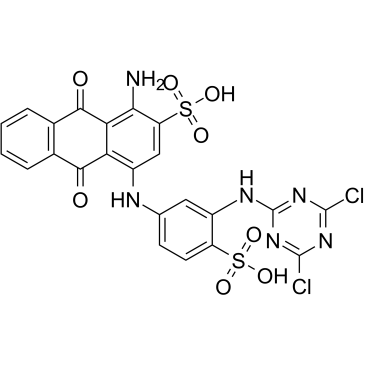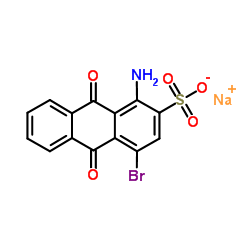13324-20-4
| 中文名 | 活性艳蓝X-ARL |
|---|---|
| 英文名 | Reactive Blue 4 |
| 中文别名 |
活性蓝4
活性艳蓝X-BR |
| 英文别名 |
MFCD00001218
EINECS 236-363-9 Procion Blue MX-R REACTIVE BLUE 4 |
| 描述 | Reactive Blue 4 是一种蒽醌类染料,能作为单一的比色化学传感器,用于在水介质中连续测定具有不同光学响应的多种分析物。Reactive Blue 4 具有植物毒性、细胞毒性和基因毒性。 |
|---|---|
| 相关类别 | |
| 参考文献 |
| 密度 | 1.86g/cm3 |
|---|---|
| 分子式 | C23H14Cl2N6O8S2 |
| 分子量 | 637.42900 |
| 精确质量 | 635.96900 |
| PSA | 248.39000 |
| LogP | 6.40540 |
| 外观性状 | saline suspension |
| 折射率 | 1.774 |
| 储存条件 | 常温密闭,阴凉通风干燥 |
| 稳定性 | 常温常压下稳定 避免的物料 氧化物 |
| 分子结构 | 1、 摩尔折射率:142.98 2、 摩尔体积(m3/mol):342.5 3、 等张比容(90.2K):1114.1 4、 表面张力(dyne/cm):111.9 5、 极化率(10-24cm3):56.68 |
| 计算化学 | 1.疏水参数计算参考值(XlogP):4.7 2.氢键供体数量:5 3.氢键受体数量:14 4.可旋转化学键数量:6 5.互变异构体数量:36 6.拓扑分子极性表面积248 7.重原子数量:41 8.表面电荷:0 9.复杂度:1220 10.同位素原子数量:0 11.确定原子立构中心数量:0 12.不确定原子立构中心数量:0 13.确定化学键立构中心数量:0 14.不确定化学键立构中心数量:0 15.共价键单元数量:1 |
| 更多 | 1. 性状:深蓝色粉状 2. 密度(g/mL, 25 ℃ ):未确定 3. 相对蒸汽密度(g/mL,空气=1):未确定 4. 熔点(ºC):16-18 5. 沸点(ºC,常压):未确定 6. 沸点(ºC,5mmHg):未确定 7. 折射率:未确定 8. 闪点(ºC):未确定 9. 比旋光度(º):未确定 10. 自燃点或引燃温度(ºC):未确定 11. 蒸气压(20ºC):0.1mmHg 12. 饱和蒸气压(kPa,60ºC):未确定 13. 燃烧热(KJ/mol):未确定 14. 临界温度(ºC):未确定 15. 临界压力(KPa):未确定 16. 油水(辛醇/水)分配系数的对数值:未确定 17. 爆炸上限(%,V/V):未确定 18. 爆炸下限(%,V/V):未确定 19. 溶解性:溶于水, 50 ℃ 时为 90g /L。 20 ℃ 时为 80g /L |
|
SECTION 1: Identification of the substance/mixture and of the company/undertaking Product identifiers Product name: Reactive Blue 4 REACH No.: A registration number is not available for this substance as the substance or its uses are exempted from registration, the annual tonnage does not require a registration or the registration is envisaged for a later registration deadline.
CAS-No.: 13324-20-4 SECTION 2: Hazards identification Classification of the substance or mixture Classification according to Regulation (EC) No 1272/2008 Eye irritation (Category 2), H319 For the full text of the H-Statements mentioned in this Section, see Section 16. Classification according to EU Directives 67/548/EEC or 1999/45/EC Xi IrritantR36 For the full text of the R-phrases mentioned in this Section, see Section 16. Label elements Labelling according Regulation (EC) No 1272/2008 Pictogram Signal wordWarning Hazard statement(s) Causes serious eye irritation. Precautionary statement(s) P305 + P351 + P338IF IN EYES: Rinse cautiously with water for several minutes. Remove contact lenses, if present and easy to do. Continue rinsing. Supplemental Hazardnone Statements Other hazards - none SECTION 3: Composition/information on ingredients Substances Synonyms: Procion® blue MX-R 1-Amino-4-[3-(4,6-dichlorotriazin-2-ylamino)-4- sulfophenylamino]anthraquinone-2-sulfonic acid Formula: C23H14Cl2N6O8S2 Molecular Weight: 637,43 g/mol CAS-No.: 13324-20-4 EC-No.: 236-363-9 Hazardous ingredients according to Regulation (EC) No 1272/2008 ComponentClassificationConcentration 1-Amino-4-(2'-(4'',6''-dichloro-s-triazin-2-yl)amino)phenylamino)9,10-dihydro-9,10-dioxoanthracene- 2,4'-disulphonic acid CAS-No.13324-20-4Eye Irrit. 2; H319<= 100 % EC-No.236-363-9 Hazardous ingredients according to Directive 1999/45/EC ComponentClassificationConcentration 1-Amino-4-(2'-(4'',6''-dichloro-s-triazin-2-yl)amino)phenylamino)9,10-dihydro-9,10-dioxoanthracene- 2,4'-disulphonic acid CAS-No.13324-20-4Xi, R36<= 100 % EC-No.236-363-9 For the full text of the H-Statements and R-Phrases mentioned in this Section, see Section 16 SECTION 4: First aid measures Description of first aid measures General advice Consult a physician. Show this safety data sheet to the doctor in attendance. If inhaled If breathed in, move person into fresh air. If not breathing, give artificial respiration. Consult a physician. In case of skin contact Wash off with soap and plenty of water. Consult a physician. In case of eye contact Rinse thoroughly with plenty of water for at least 15 minutes and consult a physician. If swallowed Never give anything by mouth to an unconscious person. Rinse mouth with water. Consult a physician. Most important symptoms and effects, both acute and delayed The most important known symptoms and effects are described in the labelling (see section 2.2) and/or in section 11 Indication of any immediate medical attention and special treatment needed no data available SECTION 5: Firefighting measures Extinguishing media Suitable extinguishing media Use water spray, alcohol-resistant foam, dry chemical or carbon dioxide. Special hazards arising from the substance or mixture Carbon oxides, nitrogen oxides (NOx), Sulphur oxides, Hydrogen chloride gas Advice for firefighters Wear self contained breathing apparatus for fire fighting if necessary. Further information no data available SECTION 6: Accidental release measures Personal precautions, protective equipment and emergency procedures Use personal protective equipment. Avoid dust formation. Avoid breathing vapours, mist or gas. Ensure adequate ventilation. Avoid breathing dust. For personal protection see section 8. Environmental precautions Do not let product enter drains. Methods and materials for containment and cleaning up Pick up and arrange disposal without creating dust. Sweep up and shovel. Keep in suitable, closed containers for disposal. Reference to other sections For disposal see section 13. SECTION 7: Handling and storage Precautions for safe handling Avoid contact with skin and eyes. Avoid formation of dust and aerosols. Provide appropriate exhaust ventilation at places where dust is formed.Normal measures for preventive fire protection. For precautions see section 2.2. Conditions for safe storage, including any incompatibilities Store in cool place. Keep container tightly closed in a dry and well-ventilated place. Specific end use(s) A part from the uses mentioned in section 1.2 no other specific uses are stipulated SECTION 8: Exposure controls/personal protection Control parameters Components with workplace control parameters Exposure controls Appropriate engineering controls Handle in accordance with good industrial hygiene and safety practice. Wash hands before breaks and at the end of workday. Personal protective equipment Eye/face protection Safety glasses with side-shields conforming to EN166 Use equipment for eye protection tested and approved under appropriate government standards such as NIOSH (US) or EN 166(EU). Skin protection Handle with gloves. Gloves must be inspected prior to use. Use proper glove removal technique (without touching glove's outer surface) to avoid skin contact with this product. Dispose of contaminated gloves after use in accordance with applicable laws and good laboratory practices. Wash and dry hands. The selected protective gloves have to satisfy the specifications of EU Directive 89/686/EEC and the standard EN 374 derived from it. Body Protection impervious clothing, The type of protective equipment must be selected according to the concentration and amount of the dangerous substance at the specific workplace. Respiratory protection For nuisance exposures use type P95 (US) or type P1 (EU EN 143) particle respirator.For higher level protection use type OV/AG/P99 (US) or type ABEK-P2 (EU EN 143) respirator cartridges. Use respirators and components tested and approved under appropriate government standards such as NIOSH (US) or CEN (EU). Control of environmental exposure Do not let product enter drains. SECTION 9: Physical and chemical properties Information on basic physical and chemical properties a) AppearanceForm: powder b) Odourno data available c) Odour Thresholdno data available d) pHno data available e) Melting point/freezingno data available point f) Initial boiling point and no data available boiling range g) Flash pointno data available h) Evapouration rateno data available i) Flammability (solid, gas) no data available j) Upper/lowerno data available flammability or explosive limits k) Vapour pressureno data available l) Vapour densityno data available m) Relative densityno data available n) Water solubilityno data available o) Partition coefficient: n- no data available octanol/water p) Auto-ignitionno data available temperature q) Decompositionno data available temperature r) Viscosityno data available s) Explosive propertiesno data available t) Oxidizing propertiesno data available Other safety information no data available SECTION 10: Stability and reactivity Reactivity no data available Chemical stability Stable under recommended storage conditions. Possibility of hazardous reactions no data available Conditions to avoid no data available Incompatible materials Strong oxidizing agents Hazardous decomposition products Other decomposition products - no data available In the event of fire: see section 5 SECTION 11: Toxicological information Information on toxicological effects Acute toxicity LD50 Oral - rat - 8.980 mg/kg Skin corrosion/irritation Serious eye damage/eye irritation Eyes - rabbit Result: Moderate eye irritation - 24 h Remarks: Eye irritation Respiratory or skin sensitisation no data available Germ cell mutagenicity no data available Carcinogenicity IARC:No component of this product present at levels greater than or equal to 0.1% is identified as probable, possible or confirmed human carcinogen by IARC. Reproductive toxicity no data available Specific target organ toxicity - single exposure no data available Specific target organ toxicity - repeated exposure no data available Aspiration hazard no data available Additional Information RTECS: CB1030000 To the best of our knowledge, the chemical, physical, and toxicological properties have not been thoroughly investigated. SECTION 12: Ecological information Toxicity Persistence and degradability Bioaccumulative potential no data available Mobility in soil no data available Results of PBT and vPvB assessment PBT/vPvB assessment not available as chemical safety assessment not required/not conducted Other adverse effects SECTION 13: Disposal considerations Waste treatment methods Product Offer surplus and non-recyclable solutions to a licensed disposal company. Contact a licensed professional waste disposal service to dispose of this material. Dissolve or mix the material with a combustible solvent and burn in a chemical incinerator equipped with an afterburner and scrubber. Contaminated packaging Dispose of as unused product. SECTION 14: Transport information UN number ADR/RID: -IMDG: -IATA: - UN proper shipping name ADR/RID: Not dangerous goods IMDG: Not dangerous goods IATA:Not dangerous goods Transport hazard class(es) ADR/RID: -IMDG: -IATA: - Packaging group ADR/RID: -IMDG: -IATA: - Environmental hazards ADR/RID: noIMDG Marine pollutant: noIATA: no Special precautions for user no data available SECTION 15: Regulatory information This safety datasheet complies with the requirements of Regulation (EC) No. 1907/2006. Safety, health and environmental regulations/legislation specific for the substance or mixture no data available Chemical Safety Assessment Full text of R-phrases referred to under sections 2 and 3 Xi Irritant R36 Irritating to eyes. Further information only. The above information is believed to be correct but does not purport to be all inclusive and shall be used only as a guide. The information in this document is based on the present state of our knowledge and is applicable to the product with regard to appropriate safety precautions. It does not represent any SECTION 16 - ADDITIONAL INFORMATION N/A |
|
毒理学数据: 1. 急性毒性:大鼠口服LD50:8980mg/kg 2. 皮肤眼睛刺激数据:兔子眼睛标准刺激测试:100 mg/24HREACTION SEVERITY : Moderate 生态学数据: 通常对水体是稍微有害的,不要将未稀释或大量产品接触地下水,水道或污水系统,未经政府许可勿将材料排入周围环境。 CHEMICAL IDENTIFICATION
HEALTH HAZARD DATAACUTE TOXICITY DATA
|
| 符号 |

GHS07 |
|---|---|
| 信号词 | Warning |
| 危害声明 | H319 |
| 警示性声明 | P305 + P351 + P338 |
| 个人防护装备 | dust mask type N95 (US);Eyeshields;Gloves |
| 危害码 (欧洲) | Xi |
| 风险声明 (欧洲) | 36 |
| 安全声明 (欧洲) | S22-S24/25 |
| 危险品运输编码 | NONH for all modes of transport |
| WGK德国 | 3 |
| RTECS号 | CB1030000 |
|
~% 
13324-20-4 |
| 文献:Journal of Medicinal Chemistry, , vol. 54, # 3 p. 817 - 830 |
| 上游产品 1 | |
|---|---|
| 下游产品 0 | |


